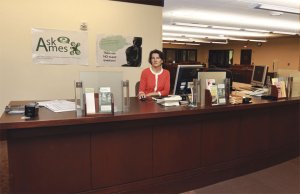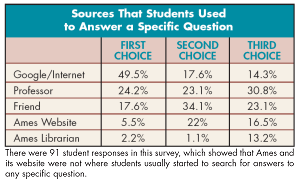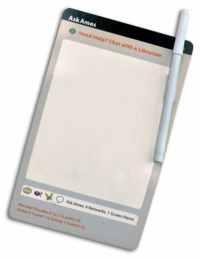 |
| Co-author Lynda Duke poses here at the information desk after the AskAmes
banner was added to encourage more student usage. |
The Ames Library at Illinois Wesleyan University (IWU) has struggled in the recent past to maintain students’ interest in using reference services. Ames, which serves IWU, a private liberal arts college comprising 2,100 students, is not unlike a lot of college and university libraries in this regard. To try to address this issue, two of us, Lynda Duke and Jean MacDonald, worked collaboratively with three marketing classes over two semesters.
Our Initial Collaboration
By 2007, The Ames Library was intensifying its efforts to market its reference services. In addition to the declining reference statistics, two major developments helped to further focus and shape this endeavor. First, a visiting librarian, Jean MacDonald, was hired and charged with leading the library faculty in an effort to overhaul reference services. Second, the leader of the Library Marketing Team (LMT), Lynda Duke, was developing a close working relationship with Carrie Trimble, a professor in the business administration department. As Lynda taught instruction sessions for Trimble’s marketing classes, it became clear to her that Trimble was eager to have her marketing students work on “real-world” problems.
Once it became apparent that promoting reference services would become a main goal of the LMT, it was easy to convince Trimble to assign this project to her two classes called Marketing: Principles and Management. We made it clear in our initial discussions that the library’s goals were to assess the reference services’ visibility and use by students, to implement changes that would make reference services more visible and useful to students, and then to promote the “new and improved” service. We told Trimble that we were wide open regarding how the students accomplished this, and we left it to her discretion to design the assignments. We would provide information about the overall problem as needed.
Professor Trimble made this “service learning opportunity” a required component of her introductory marketing course. This is a form of project-based learning, fully integrated into the classroom, in which academic goals are accomplished by working with a real-world client. Several facts made this project particularly appealing to all parties: Assignments were grounded in a real-world need, students could easily grasp the impact and scope of their work, and students would get to apply theoretical concepts to an actual problem. Our hopes were twofold: First, Trimble would see more enthusiasm among her students and give them a better understanding of the academic concepts she was teaching. Second, the library would benefit from the data gathering, analysis, and recommendations of the students.
Students Get the Assignment
Once the semester began, Lynda met with the students in order to explain how the reference desk was currently structured and to provide general context to the problem. For the first class assignment, Trimble broke her students into teams and asked them to create and implement one survey that would provide insights about students’ opinions of reference and how often (if ever!) they used the service. In business administration parlance, this is referred to as a “current situation analysis.”
In order to allow the students to take charge of the project, the LMT (which consisted of several staff members in addition to Lynda, the chair, and Jean) provided them with very few requirements for the survey. We only required them to include questions about when, if ever, a student had consulted with a librarian in the past and why or why not. But otherwise, the students generated the bulk of the survey questions. In addition to basic demographic inquiries, the survey asked participants to identify when they were last in the library and why.
 |
Having two sections of this marketing class formulate, administer, and analyze a survey resulted in many more respondents and a wider range of information being gathered. Both sections administered an online survey, but each had a different focus. One was very general in scope, while the other sought answers to questions such as “Where do students go first when doing their research?” and “How much time do participants spend with each research resource before choosing to consult another?”
And the Surveys Say . . .
The results of the surveys confirmed our belief that IWU students are fond of The Ames Library facility (it is new and attractive), but they fail to use its resources, specifically the reference desk, to the fullest. The heart of what these surveys revealed was that IWU students tend to be self-assured and technologically savvy while also pressed for time and unwilling to ask for assistance.
Survey questions designed to measure students’ habits in completing assignments highlighted their comfort with using technology and showed that they were very likely to use Google as their main resource and to ask their peers or professors for help but that they were not inclined to ask librarians for help.
It was quite disheartening to learn that the only time most students thought to ask a librarian for help was to troubleshoot technical problems, such as a printer jam.
After analyzing the survey results, Trimble tasked her students with providing recommendations for changing reference services, with the end goal of increasing reference interactions between students and librarians. The marketing classes’ students wrote up their findings and submitted their projects to their professor for grading.
Librarians’ Response to the Survey
| After reading the survey results, it became obvious that the words ‘reference’ and ‘information’ had little to no meaning to our students. |
At the end of the semester, we received copies of the students’ final reports, removed all identifying information, and distributed copies to all librarians for their review. These reports addressed the visibility and functionality of reference services and helped to inform the discussion that Jean conducted with library faculty about possible changes to our reference services. After reading the survey results, it became obvious that the words “reference” and “information” had little to no meaning to our students. (Interestingly, some librarians found this surprising, and others expected this result.) In any case, we realized that the sign hanging over the reference desk saying “Information Desk” might not be as effective
as we would have liked it to be. Consequently, and after much discussion, we adopted a picture of a large yellow “help button” with a question mark on it as a secondary sign. This help button sign was hung immediately below the original, more formal “Information Desk” sign.
The marketing students strongly advocated starting an instant messaging (IM) reference service. Notably, they suggested using IM reference as a means to address students’ reticence toward approaching us face to face while also catering to their short attention spans. After the library faculty endorsed such a venture, the visiting librarian reviewed various software packages used for IM reference and ultimately chose Meebo because of its ability to work with AIM, Yahoo!, Google Talk, and MSN chat software. The fact that the Meebo widget could be embedded into library webpages made the decision to use it remarkably simple, and its high visibility promised a great opportunity to promote reference interactions with anyone who visited our webpages.
 To complement the launch of the new IM reference service, the LMT developed a strategy for promoting it. In addition to announcements posted on the campus web portal and an article in the weekly student newspaper, the promotion included 8.5" x 11" whiteboards that the LMT ordered. On these 2,000 whiteboards, which were designed to look like the Meebo widget, we had printed the hours of IM availability. We distributed these promotional products to every student living on campus, both in the residence halls and the Greek houses. Additionally, we left a supply at the reference desk for students to pick up and take to their off-campus housing. To complement the launch of the new IM reference service, the LMT developed a strategy for promoting it. In addition to announcements posted on the campus web portal and an article in the weekly student newspaper, the promotion included 8.5" x 11" whiteboards that the LMT ordered. On these 2,000 whiteboards, which were designed to look like the Meebo widget, we had printed the hours of IM availability. We distributed these promotional products to every student living on campus, both in the residence halls and the Greek houses. Additionally, we left a supply at the reference desk for students to pick up and take to their off-campus housing.
Another issue that came to light from the survey findings was the need to strengthen awareness of Ames’ email reference service. To address this awareness gap, the LMT ordered small penlight key chains imprinted with the URL of a page that listed the various ways of contacting a librarian: IM, email, phone, office hours, by appointment, and desk hours. We gave these key chains to all first-year and transfer students during their orientation sessions.
The marketing students also suggested that the library offer walk-in workshops to students on specific topics of interest. After some discussion, the library faculty decided not to pursue this venture in light of its failure to attract students in the past. However, the library faculty did decide to further cultivate relationships with students in Greek societies, sports teams, and residence halls in an effort to provide information directly to them. Once contacted, a handful of these groups scheduled time with a librarian to learn how to improve their research skills.
One of the most visible impacts of this collaboration between librarians and the marketing classes was the student assistant/librarian configuration at the reference desk. Specifically, librarians assumed the student-assistant position at the desk, namely, front and center (as opposed to behind and to the side in the desk’s L-shape configuration). Our student workers, then, sat in the position the librarians had
been using. We hoped that this change in seating arrangements would make the librarians more visible to students who needed help in the library and thus increase the number of them who were willing to seek assistance.
The number of reference transactions with librarians, as noted on our tally sheets, jumped as a result of all of these changes, while interactions with student workers (who had assumed the spot formerly used by librarians at the desk) fell. Interestingly, however, aggregate numbers continued to trend downward, though less dramatically.
Isn’t There More We Can Do?
While all the Ames librarians agreed to the above changes with respect to providing reference services, there was still a level of uncertainty over how to proceed and what actions to take to stimulate student interest in using reference services. At this point, Lynda asked if Professor Trimble might again be interested in having her students work on this real-world issue. She enthusiastically agreed and assigned the project to her business administration course that focused on the development of marketing plans. The three of us again joined forces, this time to generate some specific marketing ideas.
As it turns out, this second class was also eager to work on this issue. Trimble divided the students into three groups to work collaboratively to generate marketing plans for our reference services. The goal of the course was to make “a pitch” for a promotional campaign by the end of the semester and to utilize this team-based learning opportunity to its fullest. The students had complete access to the results of the surveys conducted by the two marketing classes in the previous semester, and they were expected to use this information as they formulated their marketing plans. Each team was instructed to create a campaign that included an electronic component (either a video or a podcast), a print ad, a direct marketing element (direct mail, email, or telemarketing), and an interpersonal promotional piece. For this last criterion, students could create a customer service module (for training student assistants in the library), a public relations event, or a viral (nontraditional, grass-roots) marketing item.
It is fair to say that the results of this class were mixed. As required, all plans focused on raising student awareness of reference service as a primary goal, with one group heartily pursuing the notion of advertising the advantages of using reference services to improve the academic lives of students. On the other hand, the students’ marketing plans accommodated their peers’ desire to be entertained, resulting in plans that were a bit too lighthearted in nature or simply not feasible. For example, one suggestion was that we host a carnival in the library, complete with air guitar booths.
Although we were not able to use many of the ideas generated, there were a few good suggestions. One group proposed that the library create a section for the student planners (these are calendars that the university provides to all students as classes start in the fall). The library section would highlight our slogan and outline various reference services and research sources of interest to students as well as Ames’ hours of operation and other pertinent information. We did act on this idea.
Another group suggested that the library adopt a visual identifier, such as the help button, and start using it in a consistent manner, such as on our website, in our handouts, and on sidewalk messages (as a part of a grass-roots effort). Eventually, we did this and had Zigmund Sun Oo, a student who was majoring in graphic design, create an identifier using our new slogan “AskAmes.” This replaced the yellow help button.
In the end, we think that this second attempt to collaborate was less useful for us. Generally speaking, the suggestions did not fit for the image that we wanted to portray and were not as appropriate for the real world as they seemed on paper. Despite the lack of success with this class, we would still recommend trying this approach, with the caveat that those who undertake this give more parameters to the students regarding the feasibility of their final plans.
Both Groups Learned Something
From the perspective of the students in these three university classes, working with the library was surely an eye-opening experience. While many marketing students are forced to use theoretical or otherwise abstract scenarios when learning marketing practices, this was not the case here. Further, they learned that making a product’s value personal (i.e., demonstrating how using the reference service improves student performance in the classroom) is the best approach to take when developing marketing plans.
The impact of the working relationship between the library and the marketing classes was also noteworthy from the librarians’ perspective. The student findings and suggestions from all three classes informed decisions made by The Ames Library staff with respect to reference services and fostered a greater sense of community between the librarians and IWU students.
|